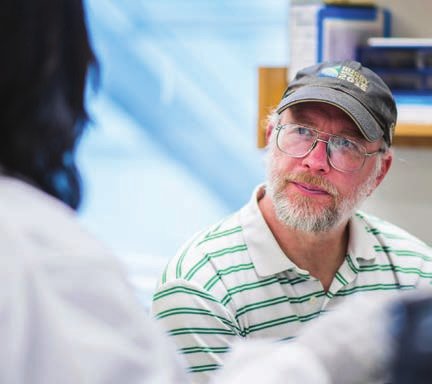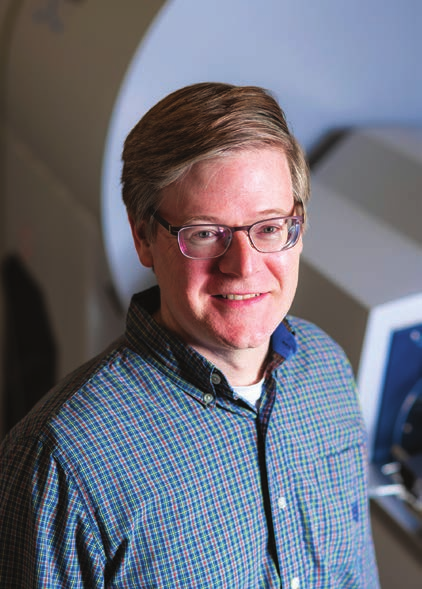You may have heard that personalized health care is in our not-so-distant future. But for some Faculty of Science researchers, the future is already here. These trailblazers study the human body on a molecular level.
Lovingly referred to as omics, scientists in this field are experts in genomics, proteomics, metabolomics, and glycomics. Despite their main subject of study-from genes to proteins and metabolites to sugars-the main thrust of omics research is to understand our world molecule by molecule, examining how each unique element combines and interacts to shape each one of us in unique and dynamic ways.
Learn how these Faculty of Science omics researchers are leading the way in metabolomics and glycomics and changing the face of health care, both in Canada and around the world.
(metabolomics)
What if you knew now how healthy (or unhealthy) you'd be in 10 years? And what if, armed with that information, you were given simple, straightforward solutions to implement now that would prevent you from becoming ill in the future in the first place?
Sound like science fiction? Believe it or not, the science behind these impressive ideas already exists, thanks to a revolutionary field of research called metabolomics.
Predicting and preventing disease
Metabolomics is the study of metabolism, and it is one key to predicting and detecting disease, explains biochemist David Wishart ('83 BSc).
Through his research, Wishart and his colleagues identify and catalogue every chemical in the human body, looking for patterns that correspond to different illnesses. This work allows practitioners to tailor care for each patient, based on their makeup at a molecular level. "There's a huge impact in terms of lives saved and quality of life, not to mention dollars," explains Wishart.
For example, one study uses biomarkers in blood to detect early-stage diabetes, says Wishart. "In many cases, we can predict the disease up to 10 years before it actually develops. If you can make an intervention before the disease develops, that can save thousands of lives."
Another test, not yet available in Canada, will catch colon cancer at the polyp stage, without a colonoscopy. This early detection could improve cure rates from 50 to 95 per cent. It could also reduce health‐care costs by about $2 billion annually, says Wishart.
Wishart's research at the Metabolomics Innovation Centre at the U of A and his work through the Human Metabolome Project are available, open access, to researchers around the world and are accessed by millions of users each year.
"Making ideas available for other scientists moves our whole field forward faster," Wishart says. "We're helping patients, we're treating people, and we're changing lives for the better."
(glycomics)
Much like metabolomics, glycomics is the study of certain molecules in a biological system, only in this case, the focus is on sugars, rather than metabolites. Chains of sugars, called glycans, play a major role in human health-from the benefits of breast milk to the functioning of our immune systems. The most abundant biomolecule on the planet, sugars are one of the fundamental building blocks of our bodies and the world around us. And the better we understand them, the larger the role glycomics can play in health care.
Why breast milk benefits babies
As any parent knows, human breast milk has many benefits for infants, including protection against pathogens such as norovirus and cholera, providing prebiotics to promote the growth of a healthy microbiota, and supporting the developing immune system. Many of these health benefits come from sugars in the breast milk called human milk oligosaccharides, or HMOs. But for parents who do not or cannot nurse their babies, formula cannot provide the same protections and natural benefits as breast milk, because it lacks this key ingredient.
To help formula makers help mothers, enter UAlberta chemist John Klassen, the scientist behind the launch of a new HMO library screening facility.
Klassen and his colleagues have developed a mass spectrometry technique for studying the interactions that HMOs make with human and microbial proteins. The technique identifies HMO binding from changes in the molecular weights of proteins. By gaining key insights into how HMOs work, Klassen aims to help formula producers emulate the natural benefits of breast milk.
Glycomics expertise
UAlberta has an impressive track record of glycomics expertise, from Ray (Sugar Ray) Lemieux ('43 BSc, '91 DSc) to David Bundle, Todd Lowary ('93 PhD), Chris Cairo, and Ratmir Derda among others. The Faculty of Science is proud to host two glycomics powerhouses, including Alberta Glycomics Centre as well as GlycoNet, the National Network of Centre of Excellence, housed at the University of Alberta.
"We now have an analytical method that can really push this area forward," explains Klassen. "Not only is it fast-we can screen our library of more than 45 purified HMOs in about half an hour-but it is exquisitely sensitive, and can identify very weak interactions that are undetectable by other methods."
The screening facility will soon be available to researchers around the world, including those who work with formula makers. For parents, it is one step closer to formula with the benefits of breast milk.
What makes you immune
Antibodies are small proteins created in white blood cells that prevent intruders-or antigens-from harming the human body. For instance, vaccines help our bodies to create antibodies for certain diseases, like measles, before we get infected, to keep us from getting sick in the first place when and if we are exposed.
For chemical biologist Matthew Macauley, the key to understanding the human immune response is one level deeper.
"Questions about the roles for carbohydrates in controlling immune responses are what motivates me," explains Macauley. "Tackling these challenging questions with chemical, biochemical, and genetic approaches is powerful."
He's examining how carbohydrates fine-tune antibody responses, an aspect critical for not only protection from all kinds of pathogens but also essential for understanding how autoimmunity arises.
One of the diseases Macauley studies with his colleague Klassen is Alzheimer's. The pair are examining microglia, the receptors for sugar on white blood cells in the brain called microglia. These receptors can indicate who is at risk for the disease and who is not. "There are different forms of this receptor, called protein isoforms, that have been linked to whether people are protected from the disease or not," says Macauley. "People who are protected from getting Alzheimer's have a version of that isoform that does not bind to sugars-this is the key.
Groundbreaking research for tuberculosis diagnosis
Todd Lowary, Raymond Lemieux Professor of Carbohydrate Chemistry, recently helped to develop a urine test that can detect tuberculosis in people living with HIV. TB is the most common cause of death for those with HIV. The test will improve the speed and accuracy of diagnosis, providing earlier treatment and improving health outcomes.
"If we can better understand the correlation between sugars and Alzheimer's, then changing or altering the sugars could potentially alter the disease," he adds.


